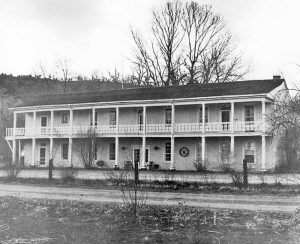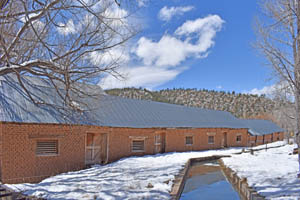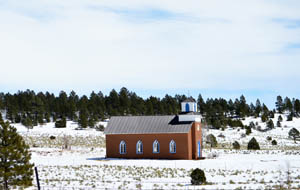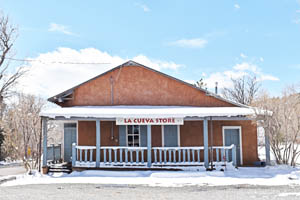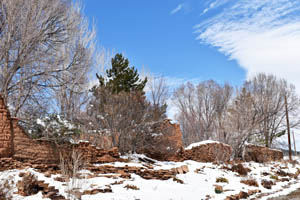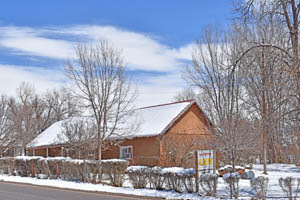La Cueva Historic District, New Mexico – Legends of America (original) (raw)
La Cueva, New Mexico Road by Kathy Alexander.
The La Cueva Historic District in Mora County, New Mexico, was founded as the La Cueva Ranch in about 1851 by Vicente Romero.
Romero Hacienda in La Cueva, New Mexico.
Located in the middle of the Mora Land Grant, Romero was not one of the original grantees but purchased shares totaling 33,000 acres from grantees or their descendants. The name La Cueva, meaning “the cave,” is attributed to Romero, a sheepherder, who utilized the many caves in the area for shelter when needed.
Romero was an important freighter and sheepman who had grown up in the area herding sheep. Originally from nearby Mora, New Mexico, when Vicente grew up, he married Maria Josefa Valdez, the daughter of an original grantee of the Mora Land Grant who owned the largest parcel of land. The couple would eventually have three children — Rafael, Maria Anastana, and Jose Antonio.
After purchasing the property, Romero soon built an 8,000-square-foot two-story adobe home for his family, and in the 1860s, a grist mill, warehouses, a mercantile building, and corrals were added. With his property nestled among three streams, Romero realized the potential of the land and the power of the nearby Mora River. In 1868, a post office was established in the mercantile building.
La Cueva, New Mexico acequia, by Kathy Alexander.
Romero diverted a portion of the Mora River into a network of acequîas (irrigation ditches) that powered the La Cueva Mill. The acequîas also provided irrigation to Romero’s farm, producing large quantities of fruit, vegetables, and grain. For a time, the mill was the primary supplier of flour and wheat to Fort Union in nearby Watrous, about 20 miles to the east. The military post was the largest fort in the Southwest and was very important in protecting travelers along the trail. At one point, the mill delivered as many as 60 horse and oxen-drawn wagons of milled grain to the fort each day. This was when the United States government established Indian reservations, and Romero’s mill provided flour to the Indians. The ranch also provided needed grain and produced to travelers along the Santa Fe Trail.
San Rafael Church in La Cueva, New Mexico, by Kathy Alexander.
Romero also began to build a church on his property in 1862. When the adobe and wood building was finished in 1870, it was called San Rafael Church for his oldest son. Priests from nearby Lamy came to help build the church, which became a family chapel for the Romeros and subsequent property owners. The gothic-style church, which shows strong French influence, was last used for mass in 1952, but it has been restored and maintained.
Soon, the small Hispanic village of La Cueva formed around Romero’s ranch and became an important trade center along the Santa Fe Trail. The Romero hacienda served as a social center for the region. The large house had a large stable where travelers could water their horses. Adobe walls in the back provided travelers and settlers protection from Indian raids. A bell used to warn settlers of attacks is still mounted on the west side of the house.
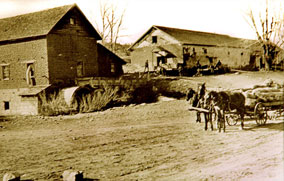
Historic mill in La Cueva, New Mexico.
Vicente Romero died on August 30, 1879, and was buried beneath the church’s altar. Years later, when his wife died, her remains were also interred there.
In 1880, the ranch officially passed to Vicente’s wife, Josepha, and his oldest son, Rafael. In September 1883, Rafael Romero, David Deuel, and Charles White incorporated the La Cueva Ranch Company to manage real estate; construct and operate irrigating ditches; raise, buy and sell livestock; and engage in merchandising, milling and farming.”
Deuel and White later bought out Romero’s interest in the La Cueva Ranch. In 1908, the rancho was listed as the second-largest in New Mexico Territory. At that time, much of the area was under cultivation, and about 4,500 head of cattle were pastured on the rancho during the winter months.
La Cueva, New Mexico Store, by Kathy Alexander.
In the following years, the ranch was broken up and sold into several parcels. However, the mill continued to grind wheat and generated electricity until the middle of the 20th century. It was also used to water 3,400 acres using the acequias and lakes.
In 1944, Colonel William Salman and his wife Frances purchased a portion of the La Cueva Ranch which he renamed the Salman Ranch. He revitalized the land by producing farm products, particularly raspberries. By 1950 Colonel Salman had reunited the five separate properties to restore the original Romero property. Colonel Salman had two sons, William and David, and a daughter, Frances. David managed the Ranch for 40 years, continuing his father’s legacy of conversation and protecting the land and its resources. When he retired, his younger sister, Frances, took over as Managing Partner. Frances continued to promote and protect the family values and land until it was sold in 2016.
The cattle-ranching Abell family of Austin, Texas, then acquired the ranch. The Abells owned adjoining property and had been operating in Northeastern New Mexico since 1996. The name was then changed to La Cueva Farm, but the family continues with the same operations, traditions, and community presence built by the Salmans. Today, La Cueva is a private residence as well as a farm. In the summer months, travelers can pick raspberries.
Corral ruins at La Cueva, New Mexico, by Kathy Alexander.
The La Cueva Historic District, encompassing 470 acres, was added to the National Register of Historic Places in 1973. Most of the original ranch buildings continue to stand, including the two-story stone and adobe La Cueva Mill, mercantile store, the large two-story hacienda, storage buildings, the San Rafael Church, stables, some acequîas, a farm, and a few outbuildings. Surrounding some of this property are corrals made of adobe and flagstone.
Although much of the mill machinery has been removed from the interior, the water wheel is still in position. Much of Romero’s elaborate irrigation system still serves the valley.
La Cueva is located five miles southeast of Mora, New Mexico, at the intersection of NM 442 and NM 518.
© Kathy Alexander/Legends of America, updated November 2022.
Also See:
La Cueva Cafe, by Kathy Alexander.
Santa Fe Trail – Highway To the Southwest
Sources:
Historic Trail Sites
La Cueva Farm
National Register Nomination
Taos County Historical Society

